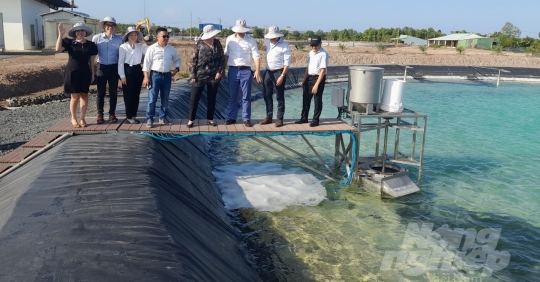Brackish water shrimp farming in the Mekong Delta is rapidly shifting towards intensive farming and is rapidly changing from the model of extensive farming of black tiger shrimp in earth ponds to intensive farming of white leg shrimp in HDPE-lined swimming ponds.
However, as of early 2022, more than 70% of intensive Vannamei shrimp farms had to reduce or stop breeding due to slow growth, white feces and white spot caused by Enterocytozoon hepatopenaei bacteria, Vibrio parahaemolyticus bacteria and white spot bacteria. This outbreak has inflicted heavy losses on the brackish water shrimp farming industry in the Mekong Delta.

The Dutch delegation visited the super-intensive shrimp farming model in Tra Vinh. Picture: Ho Thao.
Besides, to produce one ton of commercial white leg shrimp, farmers need a huge amount of resources, including 0.45 ha of arable land, 45,500 m3 of water, 0.612 tons of trash fish and 24,859 kWh of energy, which emits more than 0.612 tons of trash fish 13 tons of CO2 greenhouse gas.
In order to develop brackish water shrimp farming in a sustainable way, a new model of intensive breeding of white leg shrimp is needed, which will help farmers to use resources effectively, prevent disease, reduce production costs and avoid emissions.
To solve the above problem, a large company in Tra Vinh has researched, developed and applied the Vannamei super-intensive culture model based on 4 criteria including: conservation of mangroves; efficient use of land, water and energy resources; Circular economy combines algae, shrimp and fish farming to reduce production costs and pollution, and use renewable energy to replace energy from fossil fuel sources with zero emissions.
Currently, the new model of super-intensive Vannamei shrimp farming is being built on an area of 6ha in Tra Vinh Province, including 1ha of input water treatment area, 0.2ha of algae farming area, 1ha of commercial shrimp farming area, 2ha of mangrove conservation area, 4 acres of improved pre-processing area for gas packaging.
Specifically, the input water treatment area includes ponds that treat water with chemicals, settle sludge, filter sand, and stand by with a capacity of 10,000 m3 of water equipped with a microwave system to kill cyanobacteria without chemicals. Next is a commercial shrimp farming area consisting of 5 semi-submerged round ponds each with an area of 1,000m2 and 10 floating ponds on the bottom, each pond having an area of 500m2.
As a special feature, these shrimp ponds have an inverted conical bottom lined with HDPE tarpaulin with a siphon in the middle to effectively collect insoluble organic waste. Shrimp can be reared at a density of 300-500 shrimp/m2 at a time. The shrimp ponds are supplied with oxygen with a purity of over 90% with a plant that separates oxygen from the air with a capacity of 1,000 kg/day.

The new super-intensive shrimp farming model of a large company in Tra Vinh does not emit greenhouse gases. Picture: Ho Thao.
Each shrimp pond also has 2 multi-function systems that create a laminar flow of water in one direction to dissolve oxygen in the water. Shrimp feeding system with automatic dosing unit. Farmers also use smart sensors to monitor pH, salinity and water temperature online. In addition, shrimp ponds are also equipped with LED lights to extend the feeding time and help the shrimp grow quickly.
In addition, the mangrove reserve will be planted with 20,000 mangrove trees in combination with fish farming to help break down organic waste in shrimp pond wastewater. Water from the mangroves is pumped to the inlet, treated and reused for shrimp farming. Accordingly, the mangrove forest is able to bind 246 tons of CO2 per year. At the same time, a solar battery with a capacity of 642,142 kWh/year with 500 kWp will be installed on the roof of the pre-processing area. It is known that every kWh of electricity in Vietnam emits 0.52 kg of CO2. With the solar battery system, it is therefore possible to reduce emissions by 335 tons of CO2/year.
Nguyen Thanh My, Chairman of My Lan Group (a large company with many years of experience in the fish industry in Tra Vinh) commented: “The fact that shrimp farmers follow this model saves mangroves and increases efficiency. In particular, the oxidation technology replacing the traditional aeration method and shrimp farming combined with algae farming help farmers increase shrimp production on farmland very effectively. With such an area, the harvested shrimp production can be 240-300 tons/year.

